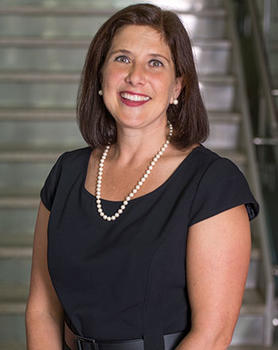In This Story
Even among the most well-intentioned organizations, traditional assumptions about gender roles and personal choices tend to invade the rhetoric, and therefore attitudes and policies, surrounding compensation and benefits in the work environment.
“In terms of a gender wage gap, women still make 82 cents on the dollar compared to men, according to 2018 U.S. Census Bureau data,” says School of Business Associate Professor Lisa Gring-Pemble. “And that gap is much larger when you factor in race and ethnicity.”
While policy and law have changed what is acceptable to discuss in the workplace, deep-rooted assumptions based on age, gender, and other attributes unrelated to job functions can limit upward mobility and earning opportunities.

“My background is rhetoric, so I care about language and the way that language shapes our beliefs and attitudes, and ultimately our actions,” says Gring-Pemble, who is co-executive director of the Business for a Better World Center at the School of Business. “So, I was really interested in knowing how the way we talk about women and women's roles and men and men's roles influences our discussions and our solutions around pay equity.”
She notes that, when the United States entered World War I and needed to get women into the workforce, there were debates on equal pay for women. But the arguments supporting equal pay for women were tempered by the assumption that it was a temporary situation—that after the war people would resume their roles of men as breadwinners and women as homemakers.
Nearly 100 years later, those attitudes persist among some lawmakers. During the debate on the Lilly Ledbetter Fair Pay Act of 2009, Gring-Pemble observed, some lawmakers still focused on equal pay in the context of marriage, or about caregiving roles assumed to be performed by women. The debate, taking place during the Great Recession, had some lawmakers arguing that women had unemployed husbands, so what was needed was to make sure that women had a job with a decent wage until their husbands could find work.
“We’re still making decisions based on a two-parent, heterosexual, nuclear family,” says Gring-Pemble. “We're not dealing with the reality of single-parent households or same-sex households. We're not dealing with the realities of the way that people live their lives; instead, we're imposing this idea that there's always a breadwinner and there's always someone who approximates a wife at home who's going to fulfill all of those unpaid duties and is somehow less valued.”
“There are different expectations of mothers and fathers. There just are,” says Gring-Pemble. “At the same time, those roles can shift over time, so the fact that we have women in the workforce in the massive numbers that we do today is not the same as it was 50 years ago—more women and men are embracing different roles, so we have more role models for what it looks like. But when we talk about desirable traits in the workplace, particularly in leadership positions, we stress qualities of assertiveness, strength, decisiveness, and logic. Many of those traits have been associated historically with what it means to be masculine. Characteristics typically and stereotypically associated with femininity like caring, emotion, and collaboration are not always highlighted as key traits in the corporate workplace. Now this is changing, but not as quickly as we might like.”
Gring-Pemble believes there are ways for businesses to start taking more of a leadership role in thinking about what kinds of benefits they provide that recognize the different stages and phases of life that employees go through, and the complexities of the lives that they live, regardless of gender, ethnicity, culture, and other differences.
“When you have predominantly white male CEOs at the heads of companies and other leadership positions, it becomes the lens by which you view things like benefits,” says Gring-Pemble. “When you bring in diverse experiences and the diverse perspectives, you recognize that there's a need for this particular group of people that you haven't considered because you haven't had to look at it from that point of view.”
“There's evidence that a lot has changed,” says Gring-Pemble. “I encourage students to get to know the trailblazers in leadership roles. Your success in this world is enhanced considerably through networking—on who you know and the connections that you make. And the students with whom I’ve had the pleasure of working at Mason are already holding businesses accountable for a more diverse and inclusive working environment.” Students entering the workforce today will be the ones who will continue to change the conversation.
